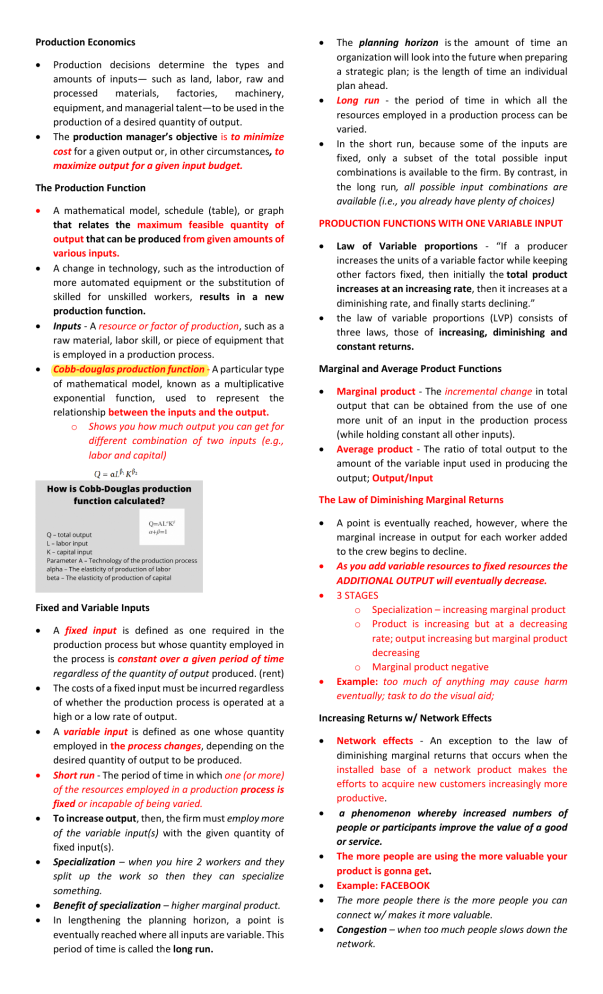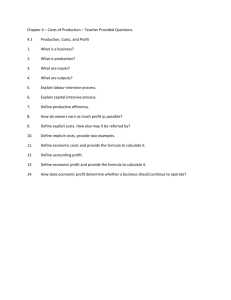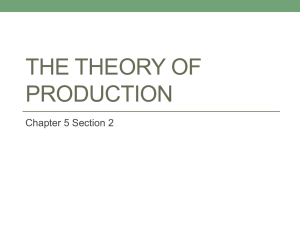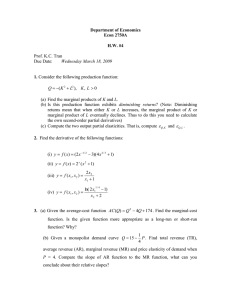
Production Economics Production decisions determine the types and amounts of inputs— such as land, labor, raw and processed materials, factories, machinery, equipment, and managerial talent—to be used in the production of a desired quantity of output. The production manager’s objective is to minimize cost for a given output or, in other circumstances, to maximize output for a given input budget. The Production Function A mathematical model, schedule (table), or graph that relates the maximum feasible quantity of output that can be produced from given amounts of various inputs. A change in technology, such as the introduction of more automated equipment or the substitution of skilled for unskilled workers, results in a new production function. Inputs - A resource or factor of production, such as a raw material, labor skill, or piece of equipment that is employed in a production process. Cobb-douglas production function - A particular type of mathematical model, known as a multiplicative exponential function, used to represent the relationship between the inputs and the output. o Shows you how much output you can get for different combination of two inputs (e.g., labor and capital) The planning horizon is the amount of time an organization will look into the future when preparing a strategic plan; is the length of time an individual plan ahead. Long run - the period of time in which all the resources employed in a production process can be varied. In the short run, because some of the inputs are fixed, only a subset of the total possible input combinations is available to the firm. By contrast, in the long run, all possible input combinations are available (i.e., you already have plenty of choices) PRODUCTION FUNCTIONS WITH ONE VARIABLE INPUT Law of Variable proportions - “If a producer increases the units of a variable factor while keeping other factors fixed, then initially the total product increases at an increasing rate, then it increases at a diminishing rate, and finally starts declining.” the law of variable proportions (LVP) consists of three laws, those of increasing, diminishing and constant returns. Marginal and Average Product Functions Marginal product - The incremental change in total output that can be obtained from the use of one more unit of an input in the production process (while holding constant all other inputs). Average product - The ratio of total output to the amount of the variable input used in producing the output; Output/Input The Law of Diminishing Marginal Returns Fixed and Variable Inputs A fixed input is defined as one required in the production process but whose quantity employed in the process is constant over a given period of time regardless of the quantity of output produced. (rent) The costs of a fixed input must be incurred regardless of whether the production process is operated at a high or a low rate of output. A variable input is defined as one whose quantity employed in the process changes, depending on the desired quantity of output to be produced. Short run - The period of time in which one (or more) of the resources employed in a production process is fixed or incapable of being varied. To increase output, then, the firm must employ more of the variable input(s) with the given quantity of fixed input(s). Specialization – when you hire 2 workers and they split up the work so then they can specialize something. Benefit of specialization – higher marginal product. In lengthening the planning horizon, a point is eventually reached where all inputs are variable. This period of time is called the long run. A point is eventually reached, however, where the marginal increase in output for each worker added to the crew begins to decline. As you add variable resources to fixed resources the ADDITIONAL OUTPUT will eventually decrease. 3 STAGES o Specialization – increasing marginal product o Product is increasing but at a decreasing rate; output increasing but marginal product decreasing o Marginal product negative Example: too much of anything may cause harm eventually; task to do the visual aid; Increasing Returns w/ Network Effects Network effects - An exception to the law of diminishing marginal returns that occurs when the installed base of a network product makes the efforts to acquire new customers increasingly more productive. a phenomenon whereby increased numbers of people or participants improve the value of a good or service. The more people are using the more valuable your product is gonna get. Example: FACEBOOK The more people there is the more people you can connect w/ makes it more valuable. Congestion – when too much people slows down the network. The greater the installed base of a network product, such as Microsoft Office and Outlook, the larger the number of compatible network connections and therefore the more possible value for a new customer. Consequently, as the software’s installed base increases, Microsoft’s promotions and other selling efforts to acquire new customers become increasingly more productive. Producing Information Services under Increasing Returns It is insightful to compare the production economics of old-economy companies that produce things to new-economy companies that produce information. Things, when sold, the seller ceases to own. Information, when sold, the seller can sell again (at least until information spillovers overwhelm the target market). Things must be replicated through expensive manufacturing processes, whereas information is replicable at almost zero incremental cost. Things exist in one location. Information can exist simultaneously in many locations. The production and marketing of things are subject to eventually diminishing returns. The marketing (and maybe the production) of information is subject to increasing returns. That is, the more people who use my information, the more likely it is that another person will want to acquire it (for any given marketing cost), or, said another way, the cheaper it is to secure another sale. Production Functions w/ Multiple Variable Inputs The Marginal Rate of Technical Substitution The Relationship between Total, Marginal, and Average Product Optimal input level - MRPL = MFCL With one of the inputs (K) fixed in the short run, the producer must determine the optimal quantity of the variable input (L) to employ in the production process. Such a determination requires the introduction into the analysis of output prices and labor costs. Therefore, the analysis begins by defining marginal revenue product and marginal factor cost. Marginal revenue product - The amount that an additional unit of the variable production input adds to total revenue. Also known as marginal value added. o In addition to indicating the quantity of output that can be produced with any of the various input combinations that lie on the isoquant curve, the isoquant also indicates the rate at which one input may be substituted for another input in producing the given quantity of output. Marginal rate of technical substitution (MRTS) - The rate at which one input may be substituted for another input in producing a given quantity of output. While the marginal rate of substitution tells us the rate at which a consumer is willing to replace one product with another, the marginal rate of technical substitution tells us the rate at which a producer is willing to switch one input. DETERMINING THE OPTIMAL COMBINATION OF INPUTS Marginal product = change output/changed input Average product = total product/total labor Average product is the average cost per unit produced per set of resources Marginal product is the cost for the very next unit to be produced in resources MP is increases (dec) the AP increases (dec). DETERMINING THE OPTIMAL USE OF THE VARIABLE INPUT Production isoquant - An algebraic function or a geometric curve representing all the various combinations of two inputs that can be used in producing a given level of output. Production isoquant shows all the alternative ways in which the number of workers and various sizes of mining equipment can be combined to produce any desired level of output. Choices are normally limited for two reasons: first, some input combinations employ an excessive quantity of one input; second, input substitution choices are also limited by the technology of production, which often involves machinery that is not divisible. The firm needs to determine which combination will minimize the total costs for producing the desired output. Isocost lines - a curve which shows various combinations of inputs that cost the same total amount; gives PERFECT SUBSTITUTES. A perfect substitute can be used in exactly the same way as the good or service it replaces. Right angle curve = perfect complements; production will only increase if both inputs are increased in the same proportion. The total cost of each possible input combination is a function of the market prices of these inputs. Assuming that the inputs are supplied in perfectly elastic fashion in competitive markets, the perunit price of each input will be constant, regardless of the amount of the input that is purchased. Marginal revenue (MR) is the increase in revenue that results from the sale of one additional unit of output. Marginal factor cost - The amount that an additional unit of the variable input adds to total cost. Perfect competition is an ideal type of market structure where all producers and consumers have full and symmetric information, no transaction costs, where there are a large number of producers and consumers competing with one another. Once the isoquants and isocosts are specified, it is possible to solve for the optimum combination of inputs. The production decision problem can be formulated in two different ways, depending on the manner in which the production objective or goal is stated. One can solve for the combination of inputs that either: Minimizes total cost subject to a given constraint on output Maximizes output subject to a given total cost constraint Measuring the Efficiency of a Production Process Minimizing Cost subject to an Output Constraint Output constraint – output limitation They occur when competitors agree to prevent, restrict or limit the volume or type of particular goods or services available. The total cost of producing the required output is minimized by finding the input combinations within this region that lie on the lowest cost isocost line. Equimarginal criterion = marginal product per variable input is equal; marginal product of variable unit per dollar is equal. Linear programming techniques are available to determine the least-cost process for fixed proportions production. feasible region is the set of all possible points (sets of values of the choice variables) of an optimization problem that satisfy the problem's constraints, potentially including inequalities, equalities, and integer constraints. Three possible relationships that can exist between the increase in inputs and the increase in outputs are as follows: o Increasing returns to scale: Output increases by more than λ; that is, Q(2) > λQ(1). o Decreasing returns to scale: Output increases by less than λ; that is, Q(2) < λQ(1). o Constant returns to scale: Output increases by exactly λ; that is, Q(2) = λQ(1). o λ equals factor increase. Production process - A fixed-proportions production relationship; inputs are combined in fixed proportion to obtain the output. Operating multiple production processes can offer a firm flexibility in dealing with unusual orders, interruptions in the availability of resources, or binding resource constraints. The isoquants of a production function with fixed proportions are L-shaped. Implies that fixed factors of production such as land, labor, raw materials are used to produce a fixed quantity of an output and these production factors cannot be substituted for the other factors. However, not all fixed-proportions production processes are equally efficient. The firm will prefer to use one or two production processes exclusively if they offer the advantage of substantial cost savings. One major argument given for initially increasing returns is the opportunity for specialization in the use of capital and labor. o Production Process and Process Rays Returns to scale - the proportionate increase in output that results from a given proportionate increase in all the inputs employed in the production process. Increasing and Decreasing Returns to Scale A Fixed Proportions Optimal Production Process Returns to Scale Measuring returns to scale Allocative efficiency - A measure of how closely production achieves the least-cost input mix or process, given the desired level of output. Technical efficiency - A measure of how closely production achieves maximum potential output given the input mix or process. Overall production efficiency - A measure of technical and allocative efficiency; is defined as the product of technical, scale, and allocative efficiency. Scale efficiency - the ability of each company to. operate as close to its most productive scale size as possible. Equipment that is more efficient in performing a limited set of tasks can be substituted for less efficient all-purpose equipment. Similarly, the efficiency of workers in performing a small number of related tasks is greater than that of less highly skilled, but more versatile, workers. Decreasing returns to scale thereafter often arises from the increasingly complex problems of coordination and control faced by management as the scale of production is increased. o For example, managers may be limited in their ability to transmit and receive status reports over a wider and wider span of control. Cobb-Douglas Production Function If β1 + β2 is less than, equal to, or greater than 1, the Cobb-Douglas production function will exhibit decreasing, constant, or increasing returns, respectively. Empirical studies of the Cobb-Douglas Production Function SUMMARY A production function is a schedule, graph, or mathematical model relating the maximum quantity of output that can be produced from various quantities of inputs. For a production function with one variable input, the marginal product is defined as the incremental change in total output that can be produced by the use of one more unit of the variable input in the production process. For a production function with one variable input, the average product is defined as the ratio of total output to the amount of the variable input used in producing the output; QUANTITY PER V-INPUT. The law of diminishing marginal returns states that, with all other productive factors held constant, the use of increasing amounts of the variable factor in the production process beyond some point will result in diminishing marginal increases in total output. Increasing returns can arise with network effects especially involving information economy goods and industry standards. In the short run, with one of the productive factors fixed, the optimal output level (and optimal level of the variable input) occurs where marginal revenue product equals marginal factor cost. Marginal revenue product is defined as the amount that an additional unit of the variable input adds to total revenue. Marginal factor cost is defined as the amount that an additional unit of the variable input adds to total cost. A production isoquant is either a geometric curve or algebraic function representing all the various combinations of inputs that can be used in producing a given level of output. The marginal rate of technical substitution is the rate at which one input may be substituted for another input in the production process, while total output remains constant. It is equal to the ratio of the marginal products of the two inputs. In the long run, with both inputs being variable, minimizing cost subject to an output constraint (or maximizing output subject to a cost constraint) requires that the production process be operated at the point where the marginal product per dollar input cost of each factor is equal (EQUIMARGINAL CRITERION). The degree of technical efficiency of a production process is the ratio of observed output to the maximum potentially feasible output for that process, given the same inputs. The degree of allocative efficiency of a production process is the ratio of total cost for producing a given output level with the least-cost process to the observed total cost of producing that output. Physical returns to scale is defined as the proportionate increase in the output of a production process that results from a given proportionate increase in all the inputs. The Cobb-Douglas production function, which is used extensively in empirical studies, is a multiplicative exponential function in which output is a (nonlinear) increasing function of each of the inputs, with the sum of the exponential parameters indicating the returns to scale.







